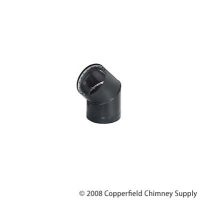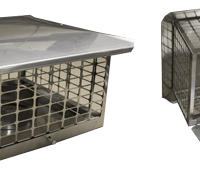The chimney anatomy is made up of several different parts. Before learning about these parts first we need to know just what is a chimney?
A chimney, in simple terms, is a vertical tube that is designed to draw combustion products from an appliance or fireplace to the outside atmosphere.
The basic parts of a chimney are:
Flues make up the inside of the chimney anatomy. There can be multiple flues located in one masonry chimney. These flues are the passageways for the smoke and gases to pass through to the outside atmosphere. It is best to have only one appliance or fireplace venting into a flue. If your home has a furnace and a wood stove your chimney should have two flues to accommodate them.
NOTE: The anatomy of a factory-built chimney contains only one passageway for venting, the inside of the pipe. Types of chimneys
Flue liners are the inner wall of the flue. Most modern masonry chimney anatomys are constructed with this liner for safety reasons, ease in cleaning and increased performance. There are several different types of flue liners. Among the most common are: terra cotta, stainless steel, aluminum, and cast in place.
For metal factory built chimney, the inner wall of the chimney also serves as the chimney liner.
The crown is the top of the masonry chimney. The edges of the crown are slightly sloped. This slope is to ensure that rain water runs off the chimney top. Most flue liners extend above the chimney crown at least two inches. In some chimneys the liner may extend higher than this depending on local building codes. This flue liner is what is usually the most visible part of the top of chimney from the ground.
The clean out door is located at the base of the each flue. It is usually a small door made of metal. When cleaning your chimney, debris will loosen and fall to the base of the flue. This debris can be removed through this clean out access. There is however an exception to this definition. A fireplace does not need a clean out door due to the fact that soot and debris will fall into the fireplace opening and can be accessed from there.
If you have a metal door that is located below the fireplace it is most likely an ash pit.
Maintenance
When maintaining your chimney, all parts of the chimney anatomy should be checked to be sure they are in proper working condition. This list of things will also be checked by a chimney professional should you decide to hire one.
The main concern of every homeowner is safety. Every year lives are lost and property is destroyed due to the improper care and maintenance of the homes chimney. A quick monthly inspection should be done during the heating season just to be sure that there are no problems forming. A professional check should be done yearly to look for the problems that only a trained eye will see.
As a homeowner there are some easy things that you can check for.
The first check that can be performed on the is a visible look at the outside of the chimney. Check for any visible cracks, holes, or loose or missing bricks. Look for crumbling mortar joints and chipped or cracked blocks or brick. Be sure that the chimney is not leaning or pulling away from the house.
NOTE: If the chimney is exposed in the attic area, be sure to check the condition of that portion also.
If you have a metal factory built chimney, look for loose sections, bending, corrosion, stains and if there is any movement of the chimney in windy conditions.
Check to be sure that there is a chimney cap in place. Water from rain and melting snow will gradually damage the inside of the chimney. If your cap is equipped with a mesh screen, be sure the screen is in tact and not clogged with leaves, nests or other debris.
Next you want to check for any leaks or stains on the inside of the home in rooms near the chimney. Stains on the wall, dampness near the chimney or peeling wallpaper are sure signs of a problem. The problem may be the result of a leaky roof flashing or it could be missing or damaged flue tiles. If this is the case consult a chimney professional.
Another area that is very important to monitor is the base of the chimney. Check chimney bases located in basements and outside the home. Check all clean out doors and take note of any debris that is stored in there. By taking a mirror and flashlight you can look up the flue from the clean out door. Try to spot any holes, separations or cracks in the flue lining. If you something that doesn’t look quite right, don’t panic. It takes a trained eye to determine just what is taking place in a chimney flue.
Last but certainly not least is the heating appliance and connecting pipes. If you have a wood stove or insert, check the condition of the pipe and connectors from the appliance to the chimney. Check for rust, holes and soft spots. If any of these things are found, replace the pipe immediately. Check the outside of the stove or insert for any cracks, rust, bulges and warping. These are all signs of damage and wear.
If you have a fireplace, be sure that the damper is working properly. Open and close it several times to be sure it works with ease and does not bind. Check the smoke chamber above the damper and make note of any soot build up. If there is a build up it is wise to clean your chimney at this time. The fireplace flue
If you have a furnace it is wise to leave that maintenance to a furnace technician. You can however check the connector pipes for signs of damage or wear.





